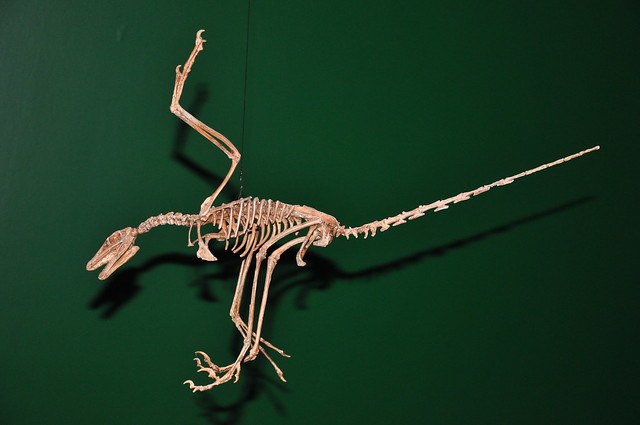This is the fifth installment in the series regarding arguments leveled against evolution and the second one regarding transitional forms. In the previous post we looked at the transition from fish to amphibian and reptile, also called Romer’s Gap. Now we turn to the feathered dinosaurs, when dinosaurs became more bird-like.
Perhaps the most famous transitional fossil is that of Archaeopteryx lithographica, found in 1861 in Germany. This means it was discovered in time for Darwin to include it in new editions of the Origin. Thomas Huxley deducted from Archaeopteryx that birds were descended from dinosaurs and later fossil discoveries confirmed his conclusion. It seems, however, that Archaeopteryx was a side-branch and not part of the actual lineage linking reptiles and birds. Archaeopteryx lived during the Jurassic period, about 150 million years ago, yet it is only one of several transitional forms. Other links between dinosaurs and birds include:
- Sinosauropteryx, had feathers, but those feathers were not suitable for flight. These feathers were probably used for warmth.
- Caudipteryx was about the size of a peacock and had symmetrical flight feathers on its forelimbs and tail.
- Confuciusornis had assymetrical flight feathers on its wings and down feathers on its body. Its skeleton was basically reptilian with long fingers, but it had a fused tail and a toothless beak. Confuciusornis, Caudipteryx, and Sinosauropteryx are part of a line that is known as the coelurosaurs.
- The coelurosaurians evolved from large theropods and included large creatures like T. rex and smaller, ostrich-like creatures which evolved into the maniraptorans, the feathered dinosaurs. It seems that the hollow bones, wishbones, and feathers were features of the maniraptorans before they were able to fly. The feathers in all probability served to keep in body heat. Archaeopteryx is part of the maniraptorans. It had feathers and was capable of flight.
- Deinonychus was built like a bird and behaved like birds do. It’s part of the velociraptor subfamily and had quite ferocious claws on its hind legs.
- Dilong paradoxus was a tyrannosaur with featherlike structures.
- Microraptor was a dinosaur that had four wings.
- Epidexipteryx was discovered in 2008 and was covered with down feathers and had four plumes for a tail.
- Numerous forms also existed during the Cretaceous period, including three lineages of modern birds: waterfowl (represented by the Cretaceous Presbyornis), loons (represented by Neogaornis), and gulls (represented by Graculavus).
- Rahonavis, from the Cretacious period, was similar to Archaeopteryx in its tail, claws and teeth, but its pelvic girdle is similar to that of birds.
- Sinornis was a feathered dinosaur with a short, fused tail, a broad breastbone, and opposable toes that enabled perching.
- Anchiornis huxleyi, discovered in 2009, is the oldest known feathered dinosaur.
In the next blog post things get closer to home as we look at the transitional forms in our own lineage.
Sources:
Cotner, S & Moore, R 2011. Arguing for evolution: An encyclopedia for understanding science. Greenwood: Santa Barbara.
Rice, S A 2007. Encyclopedia of evolution. New York: Facts on File.
Ruse, M 2006. Darwinism and its discontents. New York: Cambridge University Press.










